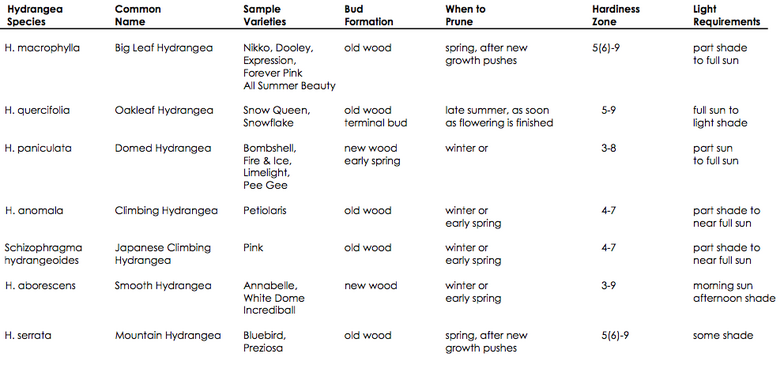Lloyd's Landscapes Inc.
"The Landscape Specialists"
PA002715 2999 State Route 890 Sunbury, PA 17801 Call us: 570-286-4377
Nursery Hours:
April - June
Mon-Tues: 8am-10am (material pick up)
Wed-Fri: 8am-6pm
Saturday: 8am-4pm
July - October
Wed-Fri: 9am - 5pm
Saturday: 8am - 1pm
November - March
Please call for an appointment 570-286-4377
Hydrangea - Cultural Information
Flower Color
Most hydrangea macrophylla and hydrangea serrata varieties are excellent ph indicators letting us know if our soil is acid or alkaline. Would you like to change your pink flowers to blue or your blue flowers to pink? If the variety you have is ph sensitive, you can add aluminum sulfate to acidify your soil for blue flowers, or lime to make your soil alkaline for pink blossoms. If the soil has a neutral ph, the flowers will have a purple color.
No Flowers
Most often this is only a problem with hydrangeas macrophylla, quercifolia, and serrata. Following are several reasons why your hydrangeas may not produce flowers.
- The plant is not getting enough sunlight. Although they like dappled sunlight or morning sun with afternoon shade, if a hydrangea is primarily in shade most of the day, it will produce few flowers
- The plant is exposed to too much cold weather in the winter and early spring, causing the stems to die back or flower buds to freeze. Try wrapping the shrub with a cage made of burlap and wooden stakes. Fill it with leaves or loose straw to give added insulation throughout the cold winter months. Also, in the spring when it begins to warm up, the plants will start pushing their new growth. When followed by freezing temperatures or heavy frosts, tender flower buds that have just started to open can freeze and die. Only remove the protection after you are fairly certain there won’t be any late freezes.
- The plant may have an imbalance of available nutrients. Make sure you aren’t feeding your hydrangea with a fertilizer that is too high in nitrogen. Nitrogen is the first number listed in the N-P-K ratio on all fertilizers. Some of the most commonly used fertilizers (the ones that turn the water blue) are often very high in nitrogen depending on the formulation that you buy. Too much nitrogen will cause a plant to put most of its energy into stem and leaf growth, sacrificing the production of flower buds. Instead, look for a fertilizer labeled for flowering plants that is higher in phosphorus. Phosphorus is the middle number in the N-P-K ratio and it helps to promote formation of flower buds. Do not, however, be tempted to add super high amounts of Phosphorus to your soil. Remember, a proper balance of plant nutrients is the key. Always read and follow the product labels for how much fertilizer to use and how often to apply it. If you don’t know what nutrients are available in your soil, it’s always best to test the soil first because too much of any nutrient is not good for your plants.
Soil and Moisture Preferences
In general, hydrangeas like to grow in a humus rich soil that is moist, but well drained (not soggy).
Light
Although hydrangeas thrive in dappled sun, or full sun in the morning with afternoon shade, most varieties will also grow very well in full sun as long as they are given ample amounts of water.

